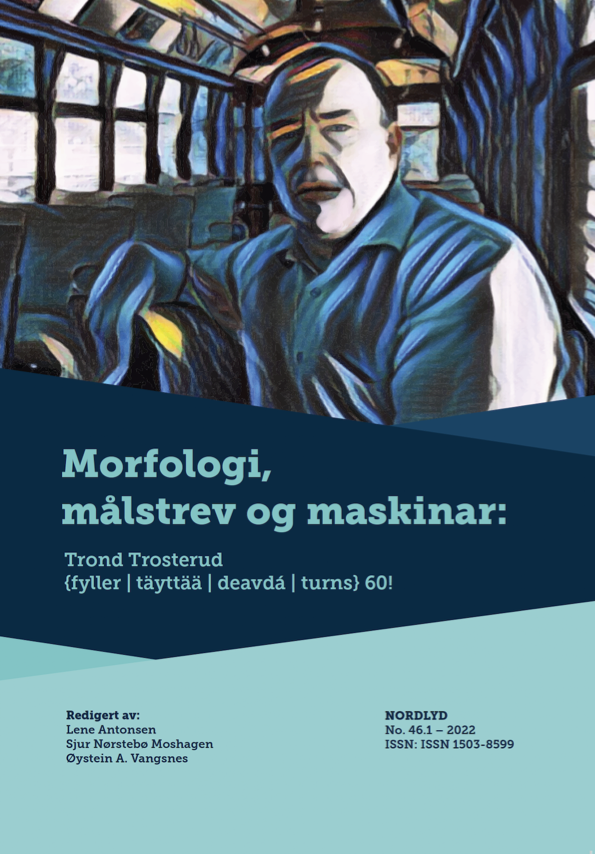The Preconceptual Basis of Noun Class (Gender)
DOI:
https://doi.org/10.7557/12.6371Keywords:
noun class, morphosyntactic features, attention, agency detection, sex discriminationAbstract
Noun class is widely seen as “standing out” from other morphosyntactic categories in having a basis in ontological beliefs, or a ‘semantic core’. The consequence of this view is that noun classes in natural languages frequently do not cohere semantically. Here I motivate an aspectual alternative according to which noun class is grounded in low-level cognitive processes including the detection of agency and sex-related cues (including shape/size) and ‘mode’ of attention. This suggests a way of bringing noun class more into line with the perspectivizing contribution of morphosyntactic features in general.
References
Aikhenvald, Alexandra Y. 2000. Classifiers: a typology of noun categorization devices. Oxford University Press, Oxford.
Allan, Edward. 1976. Dizi. In The non-Semitic languages of Ethiopia, edited by M. Lionel Bender, pp. 377–392. African Studies Center, Michigan State University, East Lansing, MI.
Asher, R. E. 1989 [1985]. Tamil. Routledge, London.
Berger, Hermann. 1974. Das Yasin-Burushaski (Werchikwar). Grammatik, Texte, Wörterbuch. Otto Harrasowitz, Wiesbaden.
Black-Rogers, Mary B. 1982. Algonquian gender revisited: animate nouns and Ojibwa ‘power’—an impasse. Papers in Linguistics 15 1: 59–76. https://doi.org/10.1080/08351818209370560.
Bourdieu, Pierre. 2000 [1972]. Esquisse d’une théorie de la pratique. Seuil, Paris.
Braine, Jean Critchfield. 1970. Nicobarese grammar (Car dialect). Ph.D. thesis, University of California at Berkeley.
Brugmann, Karl. 1897. The nature and origin of the noun genders in the Indo-European languages. Charles Scribner’s Sons, New York.
Buss, David M. 2019 [1998]. Evolutionary psychology: the new science of the mind. Routledge, London, 6th edn.
Corbett, Greville G. 1991. Gender. Cambridge University Press, Cambridge.
Corbett, Greville G. 2014. Gender typology. In The expression of gender, edited by Greville G. Corbett, pp. 87–130. Mouton de Gruyter, Berlin.
Dawkins, Richard. 2006. The God delusion. Transworld Publishers, London.
Dixon, R. M. W. 1972. The Dyirbal language of North Queensland. Cambridge University Press, Cambridge. Dreyfus, Hubert. 1991. Being-in-the-World: a commentary on Heidegger’s Being and Time. Van Gorcum, Assen, The Netherlands.
Fedden, Sebastian. 2011. A grammar of Mian. Mouton de Gruyter, Berlin.
Grimm, Jacob. 1989 [1890]. Deutsche Grammatik 3. [= Jacob Grimm und Wilhelm Grimm. Werke. Forschungsausgabe. Abteilung I. Die Werke Jacob Grimms 12]. Olms-Weidmann, Hildesheim.
Guthrie, Stewart. 1993. Faces in the clouds: a new theory of religion. Oxford University Press, Oxford. Hockett, Charles F. 1966. What Algonquian is really like. International Journal of American Linguistics 32: 59–73.
Holmquist, Jonathan Carl. 1991. Semantic features and gender dynamics in Cantabrian Spanish. Anthropological Linguistics 33 1: 57–80.
Joseph, John E. 2000. Limiting the arbitrary. John Benjamins, Amsterdam.
Kulick, Don and Angela Terrill. 2019. A grammar and dictionary of Tayap. Mouton de Gruyter, Berlin. Lakoff, George. 1987. Women, fire, and dangerous things: what categories reveal about the mind. Chicago University Press, Chicago.
Langacker, Ronald W. 2008. Cognitive grammar: a basic introduction. Oxford University Press, Oxford. Leeding, Velma J. 1989. Anindilyakwa phonology and morphology. Ph.D. thesis, University of Sydney. Lehmann, Winfred P. 1958. On earlier stages of the Indo-European nominal inflection. Language 34: 179–202. https://doi.org/10.2307/410822.
Leiss, Elisabeth. 1999. Gender in Old High German. In Gender in grammar and cognition, Vol. I: Approaches to gender, edited by Barbara Unterbeck and Matti Rissanen, pp. 237–258. Mouton de Gruyter, Berlin.
Munshi, Sadaf. 2018. Srinagar Burushaski: a descriptive and comparative account with analyzed texts. Brill, Leiden.
Mylne, Tom. 1995. Grammatical category and world view: Western colonization of the Dyirbal language. Cognitive Linguistics 6: 379–404. https://doi.org/10.1515/cogl.1995.6.4.379.
Nesset, Tore. 2001. How pervasive are sexist ideologies in grammar? In Language and Ideology: Cognitive Theoretical Approaches, edited by R. Dirven, E. Sandikcioglu, and B. Hawkins, pp. 197–227. John Benjamins, Amsterdam.
Ohala, John J. 1984. An ethological perspective on common cross-language utilization of F0 of voice. Phonetica 41: 1–16. https://doi.org/10.1159/000261706.
Payne, Doris L. 1998. Maasai gender in typological perspective. Studies in African Linguistics 27 2: 159–175. https://doi.org/10.32473/sal.v27i2.107385.
Plaster, Keith and Maria Polinsky. 2007. Women are not dangerous things: gender and categorization. Harvard Working Papers in Linguistics 12.
Reid, Nicholas J. 2011 [1990]. Ngan’gityemerri: a language of the Daly River region, Northern Territory of Australia. Lincom Europa, München.
Rijkhoff, Jan. 1991. Nominal aspect. Journal of Semantics 8 291–309. https://doi.org/10.1093/jos/8.4.291. Seiler, Hansjakob. 1986. Apprehension: language, object, and order. Part III: The universal dimension of apprehension. Gunter Narr Verlag, Tübingen.
Steinmetz, Donald. 1986. Two principles and some rules for gender in German: inanimate nouns. Word 37: 189–217.
Steinmetz, Donald. 2006. Gender shifts in Germanic and Slavic: semantic motivation for neuter. Lingua 116: 1418–1440.
Sugiyama, Lawrence S. 2016. Physical attractiveness: an adaptationist perspective. In The handbook of evolutionary psychology. Vol. 1: Foundations, edited by David M. Buss, pp. 317–384. Wiley, Hoboken, NJ.
Talbot, Mary. 2019 [1998]. Language and gender. Polity Press, Cambridge, 3rd edn.
Tichy, Eva. 1993. Kollektiva, Genus femininum und relative Chronologie im Indogermanischen. Historische Sprachforschung 106 1: 1–19.
Trosterud, Trond. 2001. Genustilordning i norsk er regelstyrt. Norsk lingvistisk tidsskrift 19: 29–58. Trosterud, Trond. 2006. Gender assignment in Old Norse. Lingua 116: 1441–1463. https://doi.org/10.1016/j.lingua.2004.06.015.
Tryon, Darrell T. 1974. Daly Family languages, Australia. Pacific Linguistics, Canberra.
Weber, Doris. 1999. On the function of gender. In Gender in grammar and cognition, Vol. I: Approaches to gender, edited by Barbara Unterbeck and Matti Rissanen, pp. 495–509. Mouton de Gruyter, Berlin. Wiltschko, Martina. 2012. Decomposing the mass/count distinction: evidence from languages that lack it. In Count and mass across languages, edited by Diane Massam, pp. 146–171. Oxford University Press, Oxford.
Downloads
Published
Issue
Section
License
Copyright (c) 2022 Patrik Bye

This work is licensed under a Creative Commons Attribution-NonCommercial 4.0 International License.





